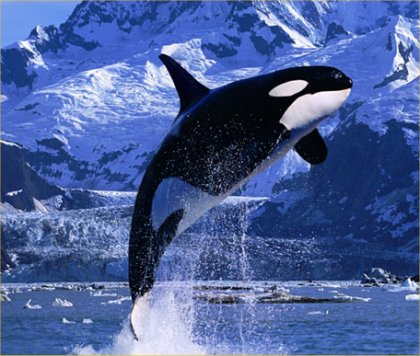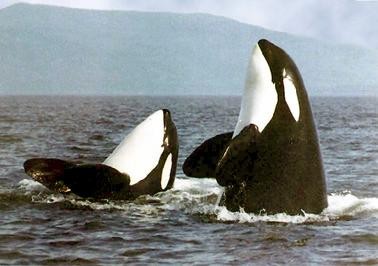
Killer Whales fall into the class of " Odontoceti," this class contains all of the toothed whales. All dolphins, porpoises, and whales are grouped together in the scientific order "Cecacea." General charecteristics of this class is having teeth, a single blowhole, no external ears, warm-blooded, and are hairless.
Common Name: Killer Whale
Scientific Name: Orcinus Orca
Phylum: Cecacea
Genus: Orcinus Orca
Species: Delphinidae
Family: Delphinidae
Description: A killer whale has a sleek streamlined body, it's characteristics make it adapted for life in an aquatic environment. Their colors are mostly black and white, the dorsal surface and pectoral flippers are black, as opposed to the area below and behind the dorsal fin which are white, the "eyespot" is located above and slightly behind their eyes. The coloration of a killer whale also enhances their ability to hunt.The top of thier bodies are black, so when viewed from the top, other animals may not see the killer whale as a threat.
Size: Males are 19-22ft., weighing between 8,000-12,000Ib. Females are 16-19ft. and weigh from 3,000-8,000Ib.
Habitats: Prominant in the Arctic, the Antarctic, and areas of cold water upwelling. Some special considerations of the Killer whales is that, although rare, they can be found in warm waters such as Hawaii, Australia, the Galapagos Islands, and the Bahamas.
Diet: Fishes, squids, sea lions, walruses, otters, penguins, whales, polar bears, reptiles. In the Antarctic, killer whales eat about 67% fishes, 27% marine mammals, and 6% squids, whereas in the Bering Sea, they eat about 65% fishes, 20% squids, and 15% marine mammals.
Physiological Features: Blood circulation, helps maintain body temperature, also, in the inner core of a killer whales eye sockets is where the secretion of a jelly-like, oily mucus lubricates the eye, whashes the debirs away, and helps streamline the eyes as the killer whale swims.
A killer whale’s forelimbs are adapted for swimming. A killer whale uses its rounded, paddlelike pectoral flippers to steer and, as opposed to its flukes, which help it to stop.
Reproductive Cycle: Studies of killer whales in marine suggest that females become sexually mature when they reach 15-16 ft., at about 6 to 10 years. Males usually become sexually mature when they reach about 18-20 ft, at about 10 to 13 years. In the wild, social factors are a great influence for a male's breeding success. Males may not successfully reproduce until they are much older, larger, and are capable to compete with other bulls.
